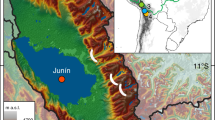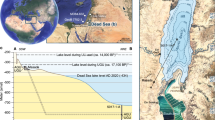Abstract
Recent studies of the Greenland ice cores have offered many insights into Holocene climatic dynamics at decadal to century timescales1,2,3. Despite the abundance of continental records of Holocene climate, few have sufficient chronological control and sampling resolution to compare with the Greenland findings4. Butannually laminated sediments (varves) from lakes can provide high-resolution continental palaeoclimate data with secure chronologies. Here we present analyses of varved sediments from Deep Lake in Minnesota, USA. Trends in the stable oxygen-isotope composition of the sedimentary carbonate indicate a pronounced climate cooling from 8.9 to 8.3 kyr before present, probably characterized by increased outbreaks of polar air, decreased precipitation temperatures, and a higher fraction of the annual precipitation falling as snow. The abrupt onset of this climate reversal, over several decades, was probably caused by a reorganization of atmospheric circulation and cooling of the Arctic airmass in summer that resulted from the final collapse of the Laurentide ice near Hudson Bay and the discharge of icebergs from the Quebec and Keewatin centres into the Tyrell Sea. The timing and duration of this climate reversal suggest that it is distinct from the prominent widespread cold snap that occurred 8,200 years ago in Greenland and other regions1,5,6. No shifts in the oxygen-isotope composition of sediment carbonate occurred at 8.2 kyr before present at Deep Lake, but varve thickness increased dramatically, probably as a result of increased deposition of aeolian dust. Taken together, our data suggest that two separate regional-scale climate reversals occurred between 9,000 and 8,000 years ago, and that they were driven by different mechanisms.
This is a preview of subscription content, access via your institution
Access options
Subscribe to this journal
Receive 51 print issues and online access
$199.00 per year
only $3.90 per issue
Buy this article
- Purchase on Springer Link
- Instant access to full article PDF
Prices may be subject to local taxes which are calculated during checkout



Similar content being viewed by others
References
Alley, R.et al. Holocene climatic instability: A prominent, widespread event 8200 yr ago. Geology 25, 483–486 (1997).
Blunier, T., Chappellaz, J., Schwander, J., Stauffer, B. & Raynaud, D. Variations in atmospheric methane concentration during the Holocene Epoch. Nature 374, 46–49 (1995).
O'Brien, S. R.et al. Complexity of Holocene climate as reconstructed from a Greenland ice core. Science 270, 1962–1964 (1995).
Wright, H. E. Jet al. Global Climate Since the Last Glacial Maximum (Univ. Minnesota Press, Minneapolis, (1993).
von Grafenstein, U., Erlenkeuser, H., Muller, J., Jouzel, J. & Johnsen, S. The cold event 8200 years ago documented in oxygen isotope records of precipitation in Europe and Greenland. Clim. Dyn. 14, 73–81 (1998).
Klitgaard-Kristensen, D., Sejrup, H. P., Haflidason, H., Johnsen, S. & Spurk, M. Aregional 8200 cal. kyr BP cooling event in northwest Europe, induced by final stages of the Laurentide ice-sheet deglaciation? J. Quat. Sci. 13, 165–169 (1998).
Stuiver, M. & Reimer, P. J. Extended 14C age calibration program. Radiocarbon 35, 215–230 (1993).
Hu, F. S., Wright, H. E. J, Ito, E. & Lease, K. Climatic effects of glacial Lake Agassiz in the midwestern United States during the last deglaciation. Geology 25, 207–210 (1997).
Teller, J. T. & Clayton, L. Glacial Lake Agassiz (Spec. Pap. 26, Geological Assoc. of Canada, Ottawa, (1983).
Dansgaard, W. Stable isotopes in precipitation. Tellus 5, 461–469 (1964).
Rozanski, K., Araguas-Araguas, L. & Gonfiantini, R. in Climate Change in Continental Isotopic Records (eds Swart, P. K., Lohmann, K. C., McKenzie, J. & Savin, S.) 1–36 (American Geophysical Union, Washington DC, (1993).
Bryson, R. A. & Hare, F. K. (eds) Climates of North America (Elsevier, New York, (1974).
Simplins, W. W. Isotopic composition of precipitation in central Iowa. J. Hydrol. 172, 185–207 (1995).
Andrews, J. T. & Falconer, G. Late glacial and postglacial history and emergence of the Ottawa Islands, Hudson Bay, N.W.T.: Evidence on the deglaciation of Hudson Bay. Can. J. Earth Sci. 6, 1263–1276 (1969).
Hardy, L. La déglaciation et les épisodes lacustre et marin sur les versants de la baie de James. Géogr. Phys. Quat. 31, 261–273 (1977).
Dyke, A. S. & Prest, V. K. Late Wisconsinan and Holocene history of the Laurentide Ice Sheet. Géogr. Phys. Quat. 41, 237–263 (1987).
Kerwin, M. W. Aregional stratigraphic isochron (ca. 8000 14C B.P.) from the final deglaciation of Hudson Strait. Quat. Res. 46, 89–98 (1996).
Manabe, S. & Stouffer, R. J. Two stable equilibra of a coupled ocean-atmosphere model. J. Clim. 7, 5–23 (1988).
de Vernal, A., Hillaire-Marcel, C., von Grafenstein, U. & Barber, D. Researchers look for links among paleoclimate events. Eos 78, 245–256 (1997).
Kutzbach, J. E. & Webb, T. II in Global Climates since the Last Glacial Maximum (eds Wright, H. E. Jr et al.) 5–11 (Univ. Minnesota Press, Minneapolis, (1993).
Wright, H. E. J Patterns of Holocene climatic change in the midwestern United States. Quat. Res. 38, 129–134 (1992).
Webb, T. II, Bartlein, P. J., Harrison, S. P. & Anderson, K. H. in Global Climates since the Last Glacial Maximum (eds Wright, H. E. Jr et al.) 415–467 (Univ. Minnesota Press, Minneapolis, (1993).
Dean, W. E. & Stuiver, M. in Elk Lake, Minnesota, Evidence for Rapid Climate Change in the North-Central United States (eds Bradbury, J. P. & Dean, W. E.) 163–180 (Spec. Pap. 276, Geological Soc. of America, Boulder, Colorado, (1993).
Laird, K. R., Fritz, S. C., Cumming, B. F. & Grimm, E. C. Early-Holocene limnological and climatic variability in the northern Great Plains. Holocene 8, 275–285 (1998).
Anderson, R. Y. in Elk Lake, Minnesota: Evidence for Rapid Climate Change in the North-Central United States (eds Bradbury, J. P. & Dean, W. E.) 45–67 (Spec. Pap. 276, Geological Soc. America, Boulder, Colorado, (1993).
Sprowl, D. R. in Elk Lake, Minnesota: Evidence for Rapid Climate Change in the North-Central United States (eds Bradbury, J. P. & Dean, W. E.) 69–74 (Spec. Pap. 276, Geological Soc. of America, Boulder, Colorado, (1993).
Barber, D. C.et al. Forcing of the cold event of 8,200 years ago by catastrophic drainage of Laurentide lakes. Nature 400, 344–348 (1999).
McCrea, J. M. On the isotopic chemistry of carbonates and paleo-temperature scale. J. Chem. Phys. 18, 849–857 (1950).
Grootes, P. M., Stuiver, M., White, J. W. C., Johnsen, S. & Jouzel, J. Comparison of oxygen isotope records from GISP2 and GRIP Greenland ice cores. Nature 366, 552–554 (1993).
Stuiver, M., Grootes, P. M. & Brazunias, T. F. The GISP2 δ18O record of the past 16,500 years and the role of the Sun, Ocean and volcanoes. Quat. Res. 44, 341–354 (1995).
Acknowledgements
We thank J. Teranes, B. Ammann, T. A. Brown, W. E. Dean, D. R. Engstrom and C. J. Mock for comments on the manuscript. This work was supported by the US National Science Foundation.
Author information
Authors and Affiliations
Corresponding author
Rights and permissions
About this article
Cite this article
Hu, F., Slawinski, D., Wright, H. et al. Abrupt changes in North American climate during early Holocene times. Nature 400, 437–440 (1999). https://doi.org/10.1038/22728
Received:
Accepted:
Issue Date:
DOI: https://doi.org/10.1038/22728
This article is cited by
-
Machine-learning based reconstructions of primary and secondary climate variables from North American and European fossil pollen data
Scientific Reports (2019)
-
Early Holocene drought in the Laurentian Great Lakes basin caused hydrologic closure of Georgian Bay
Journal of Paleolimnology (2012)
-
The sedimentary and palynological records of Serpent River Bog, and revised early Holocene lake-level changes in the Lake Huron and Georgian Bay region
Journal of Paleolimnology (2012)
-
Soil microbial responses to fire and interacting global change factors in a California annual grassland
Biogeochemistry (2012)
-
Post-glacial climate change and its effect on a shallow dimictic lake in Nova Scotia, Canada
Journal of Paleolimnology (2010)
Comments
By submitting a comment you agree to abide by our Terms and Community Guidelines. If you find something abusive or that does not comply with our terms or guidelines please flag it as inappropriate.



